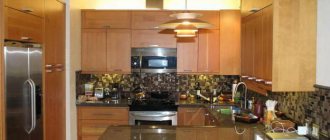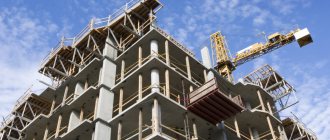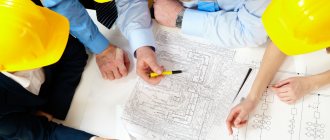Construction objects as the main result of the construction process
The construction field or construction process is one of the main branches of material production. After all, it is precisely this that creates the basis for the development of many other areas designed to satisfy the primary needs of human life.
It should be noted that humanity has accumulated vast experience in construction, which helps to erect buildings, structures, structures, as well as other construction projects.
Therefore, for everyone who plans to touch upon this area, it is quite important to navigate the construction terminology, which is regularly used in the process of constructing industrial, residential and other real estate projects.
We will try to help you understand the intricacies of the construction industry. We will teach you to determine what functional purpose certain construction projects have. We will explain what unfinished construction projects are, etc.
But first, let's take a look at the basic technical definitions.
Capital construction project
Construction objects
Construction projects are free-standing buildings, structures or structures. This also includes objects of unfinished construction (with the exception of temporary buildings, kiosks, sheds, etc.), the construction of which (possibly expansion, reconstruction or technical re-equipment) is carried out according to a separately developed project and estimate documentation.
Social buildings
- training facilities;
- administrative buildings;
- medical institutions and places of rehabilitation;
- premises for sports activities;
- clubs, restaurants, etc.;
- retail space, catering and consumer services;
- transport;
- Department of Housing and Utilities;
- multifunctional buildings and complexes.
There is a classification of buildings and structures. The required structural features are achieved using technical indicators, their use is regulated (SNiP). This document uses a varied classification of buildings and structures by type. Next, let's get acquainted with the main ones.
Functional fire hazard classes
Class F1. Premises for permanent residence and temporary (including 24-hour) stay of people
Such buildings are used around the clock, and the contingent of residents varies in age and physical health. A distinctive feature is that the room is equipped with places for sleeping, that is, a person can be here at any time of the day, and not necessarily while awake.
Class F1 is considered the most dangerous and requires maximum fire protection, since the source of fire cannot always be detected immediately, and the fire will have enough time to spread.
Subclasses:
- F1.1. “Children's preschool institutions, specialized homes for the elderly and disabled (not residential), hospitals, dormitories of boarding schools and child care institutions.” Characterized by increased complexity due to problematic evacuation in the event of a fire. The number of personnel trained in fire safety rules and capable of evacuating is less than the number of children, sick, elderly or disabled people. Also, individual premises may be classified as those in which large numbers of people are likely to be present (assembly hall, dining room, games room).
- F1.2. “Hotels, hostels, dormitories of sanatoriums and general holiday homes, campsites, motels and boarding houses.” Those inside are well versed in the area, familiar with fire safety rules, and are capable of calm evacuation in the event of a fire. A caveat is that trained personnel who know the location of fire exits and fire extinguishing equipment are significantly outnumbered by guests.
- F1.3. "Multi-apartment residential buildings." People living in such premises have different ages and health conditions. The maximum number occurs in the evening and night time. During the daytime, unaccompanied children may be present in the premises.
- F1.4. “Single-family, including blocked residential buildings.” In such buildings there is no staircase, special escape routes are not required, since each room has access to the street through a window. It is distinguished by a small number of residents, among whom there may be children.
Class F2. Entertainment, cultural and educational institutions
Such buildings are characterized by the following:
- mass presence of a healthy population of various ages at certain hours;
- the number of visitors significantly exceeds the number of service personnel;
- Most guests are not familiar with the location of fire exits and the placement of fire-fighting equipment.
Subclasses:
- F2.1. “Theaters, cinemas, concert halls, clubs, circuses, sports facilities with stands, libraries and other institutions with an estimated number of seats for visitors in enclosed spaces.” Due to the large number of seats per area, evacuation may be difficult. Current regulations prescribe the mandatory attachment of chairs to the floor surface in such premises.
- F2.2. "Museums, exhibitions, dance halls and other similar indoor establishments." The number of seats is not as large as in places of subclass F2.1., which slightly facilitates evacuation in case of fire.
- F2.3. “Institutions specified in F2.1, located outdoors.” Evacuation occurs quickly and without harm to human health.
- F2.4. “Institutions specified in F2.2, located outdoors.” The risk of injury to people present in such a place at the time of fire is minimal.
FZ class. Public service enterprises
In such establishments there are both clients and staff. The former do not have information about emergency exits, the latter are required to know. Visitors of different ages, mostly physically healthy. In terms of quantity, there are more clients than employees.
Subclasses:
- F3.1. "Trade enterprises". They assume the accumulation of a large number of people and can work around the clock. A dangerous factor for untimely detection of a fire is the presence of utility rooms where personnel are not always present.
- F3.2. "Catering establishments." Open around the clock or according to schedule (cafes, bars, restaurants, canteens). They can be located in residential buildings or detached multi-story buildings. Among the dangerous factors: mass gatherings of people, the presence of hot workshops with open fire (kitchen), utility rooms without constant human supervision. Furniture in such rooms, as a rule, is not screwed to the floor and can be moved around the room, sometimes at odds with the safe layout.
- F3.3. "Stations". All types include: bus, railway, river, airports and seaports. They work around the clock, sometimes there is a population in a sleeping state: from infants to the elderly, healthy or in wheelchairs. The feature is the massive presence of people.
- F3.4. "Polyclinics and outpatient clinics." They work during the daytime. Evacuation plans involve leaving the building through corridors and stairwells. The number of visitors exceeds the number of staff.
- F3.5. “Premises for visitors to consumer and public service enterprises.” These include notary offices, post offices, hairdressers, dry cleaners, shoe repair shops, studios, etc. They operate during the day and are equipped with highly flammable interior elements. There may be crowds of people in common rooms (operating rooms).
- F3.6. “Physical training complexes and sports training institutions without stands for spectators, household premises, baths.” In such buildings there is a main room in the form of a swimming pool, a gym and many ancillary rooms (locker rooms, showers, toilets, etc.). The number of clients is much higher than the number of staff. The fire hazard is due to the presence of furniture and some interior decoration, usually quite small. A possible source of fire could be a bathhouse or sauna room (high temperatures, wood trim).
Class F4. Educational institutions, scientific and design organizations, management institutions
The premises are used during the daytime during certain hours. The same people are present, which means they have information about fire safety rules and possible escape routes in the event of a fire. Only in some institutions there can be children, but in the majority there are adults with legal capacity.
There is a certain number of seats, utility rooms, workshops, and laboratories. Corridor-type layouts with at least two staircases.
Subclasses:
- F 4.1. “Schools, non-school educational institutions, secondary specialized educational institutions, vocational schools.” In addition to the staff, there are children of different ages, everyone is well familiar with the evacuation plan. Classrooms are located only on one side of the corridor, with windows on the other, which makes it easier to remove smoke from the building if necessary. The dining room, assembly hall and sports hall are premises with a potential large number of people.
- F 4.2. “Higher educational institutions, institutions of advanced training.” There are adults inside who visit the building every day. Well aware of fire safety rules and evacuation routes.
- F 4.3. “Institutions of governing bodies, design and engineering organizations, information and editorial and publishing organizations, research organizations, banks, offices, offices.” The corridor system of the building with offices on both sides, those inside are aware of the escape routes. Usually there are many small offices, few visitors.
- F 4.4. "Fire stations." The people here are adults and are very familiar with the layout of the premises.
Class F5. Industrial and warehouse buildings, structures and premises
There are not many workers, there are no large crowds of people. Work takes place around the clock, in shifts. The same adults with normal physical condition are present.
Subclasses:
- F 5.1. “Industrial buildings and structures, production and laboratory premises, workshops.” One building can accommodate rooms with different fire and explosion hazards (from A to D). When carrying out any manipulations, adults are always present, which guarantees instant detection of the source of fire.
- F 5.2. “Warehouse buildings and structures, parking lots for cars without maintenance and repair, book depositories, archives, warehouses.” People are not always present in technological rooms, which makes it difficult to detect fire in a timely manner. Smoke removal can be complicated by the building's lack of windows or underground location.
- F 5.3. "Agricultural buildings". Different premises have different purposes - from storage facilities to farms, product processing facilities. There are no visitors, the staff is small. They are located far from other structures, which eliminates the possibility of fire spreading quickly.
What difficulties arise in establishing a category?
There are cases when it is extremely difficult to identify the functional fire hazard class. Let's look at the example of the functional fire hazard class of a gas station. Its purpose is to sell fuel, therefore, it is an organization engaged in trade. But there are other types of gas stations where fuel is not sold, but only dispensed. From this we can conclude that the station belongs to the fifth class (F5) warehouse facilities, with equipment installed outside. The control room also belongs to F5 (a design for industrial purposes), and the store itself, installed at a gas station, belongs to F3. It is worth noting that the fire hazard class is assigned to the structure as a whole or to a separate fire sector. But, if you look at the regulations, you can find some clarifications regarding the assignment of categories. Even if there are premises with different areas of activity under the same roof, the rules will be established and put forward based on the main direction of the building in question. Or let's look at another example. The educational institution has a laboratory that belongs to F5, but the safety requirements will be put forward as for F4. For the full and safe functioning of a structure, it is important to correctly establish the functional fire hazard group and timely carry out preventive measures.
Assignment of functional fire hazard class
Functional and purpose of the premises
The legislation of the Russian Federation does not provide precise definitions of the terms “purpose of premises” and “functional purpose of premises”.
So, according to sub. 3 clause 36 of block 3.5 of the Procedure for maintaining the Unified State Register of Real Estate..., approved. By order of the Ministry of Economic Development of Russia dated December 16, 2015 No. 943, premises according to their purpose (without specifying what purpose) are divided into residential and non-residential. And then the USRN already reflects the types of permitted use of a specific premises.
Since residential premises can be used exclusively for the residence of citizens, they are not classified according to their intended purpose.
The functional purpose of non-residential premises was previously necessarily indicated in the design documentation. However, the current version of the law “On participation in shared construction” dated December 30, 2004 No. 214-FZ no longer contains a mandatory requirement to include in the information about the construction project information about the functional purpose of non-residential premises that are not related to common property (clause 24 of Art. 1 of the Law “On Amendments...” dated July 3, 2016 No. 304-FZ).
Requirements for objects of different categories of functional fire hazard in one structure
Premises with categories F2-F4 are allowed to be located within 1 fire compartment, including various technical rooms. A necessary condition is at least 3 fire hydrants. Cinema complexes with a total number of seats over 300 must be separated into separate compartments and provided with individual emergency exits and staircases in the amount of 2 or more. Each structure should be equipped with:
- systems: automatic fire extinguishing, smoke protection
- alarms
- means of rescue (for individual and general use)
- warning systems, preferably above type 4
- special water supply
The differentiation of objects with different functional categories within one structure is carried out by installing fire partitions, walls and ceilings. During the development of a multifunctional structure project, an important stage is carrying out calculations. It is with their help that you can analyze the accuracy of previously approved decisions regarding space planning work.
Fire hazard classes of building materials
Is an assessment necessary?
Before purchasing CN, an independent assessment or examination is sometimes carried out. This is especially true in the context of the cadastral method of calculating taxes.
Based on the assessment results, you can not only find out the real value of the property, but also revise the tax amount. Also, a review of the value is necessary in situations such as taking out a loan against collateral, transferring to shared ownership or leasing, concluding a marriage contract or resolving inheritance disputes.
The following documents will be required for the examination:
- certificate of registration of real estate;
- title document or lease agreement;
- owner’s passport and object’s passport;
- certificate from the BTI and premises designs.
The examination procedure is carried out in several stages.
- The technical specifications are submitted to the expert service, and once all details are agreed upon, a service agreement is concluded.
- Then the contractor is provided with all technical documentation and access to the premises.
- As a result, the customer receives a report on the work done and a final assessment of the property. The fact of transfer is recorded in the acceptance certificate.
How is a building different from a structure?
The concept of a structure is given in clause 23, part 2, art. 2 Technical Regulations:
A structure is a result of construction, which is a volumetric, planar or linear building system, having ground, above-ground and (or) underground parts, consisting of load-bearing, and in some cases, enclosing building structures and intended for performing various types of production processes, storing products, temporary stay of people, movement of people and goods.
Thus, the following criteria for distinguishing buildings from structures can be given:
- structures can be not only capital objects, but also objects, the movement of which is possible due to the lack of a strong connection with the ground (clauses 10, 10.2 of article 1 of the Civil Code of the Russian Federation);
- structures can be not only volumetric building systems, but also planar (for example, parking areas) or linear (for example, power lines);
- there may be rooms inside the structure (there are always rooms in the building), or there may not be;
- There may or may not be networks and utility systems within the structure. They are always present in the building;
- Structures can never be intended for human habitation. They can only be used for temporary stay of people, various production processes, storage of products, movement of people and goods.
Changing the floor or ceiling level
This zoning looks great and allows you to effectively highlight different zones without losing useful space. However, when planning it, you should pay attention to the following points:
- This option is not always appropriate in rooms with low ceilings.
- To prevent injuries, changes in floor level should be somehow “marked” or supplemented with another method of zoning. For example, installing a floor pot with a house plant on the border, marking it with a contrasting color, built-in lamps or railings.
Consequences of incorrect object classification
A properly established functional fire hazard class for a hospital, school or any other building is a guarantee of security. The list of rules prescribed in the relevant documentation is mandatory for execution and compliance. These rules are determined using a number of parameters, for example, assigning a functional hazard class to a structure. To avoid fire, it is necessary to correctly classify the building in question. It is the verdict rendered that will be taken into account when determining the above-mentioned rules for various institutions. If installed incorrectly, there is a high probability of a fire, since current regulations may not be followed.
Can an object temporarily have this status?
The Housing Code of the Russian Federation allows you to change the status of housing facilities, albeit with some restrictions.
Why is this necessary? The family has two apartments, one of which they do not live in. My husband supplies power tools. Volumes have increased, the number of customers is growing, you can open a store. If the spouses have a second apartment on the ground floor, they can convert it into non-residential space and equip it for a store.
Conditions for transferring a change in the status of the premises (Article 23 of the Housing Code of the Russian Federation):
- Location: The apartment is located on the ground floor or above, but there are no living spaces underneath.
- The technical condition of the apartment does not allow living in it.
- The entrance to the building must be completely isolated from the general area of the house or stairs.
Real estate is transferred from one category to another without specifying a specific period. Cases when it is impossible to change the status of an object (Articles 24, 27 of the Housing Code of the Russian Federation):
- One of the apartment owners objects.
- The majority of residents of an apartment building object - introduced in June 2021 (Federal Law of May 29, 2019 No. 116-FZ “On Amendments to the Housing Code of the Russian Federation”).
- The apartment is taken out on a mortgage.
- They live in the apartment permanently.
- If it is impossible to make a separate entrance to the room.
Before purchasing non-residential premises, you need to decide on its purpose; functionality, technical features and legal status will depend on this. And, it is advisable to carefully study the legislative framework for non-residential real estate.
If you find an error, please select a piece of text and press Ctrl+Enter.
Permitted use of the memory depending on the functional purpose
When the owner is faced with the procedure for registering ownership of a land plot, he will definitely come across the column “permitted use”. This could be land for individual housing construction, gardening, lands of DNP, DNT and SNT, commercial use, etc.
Permission to use land is granted based on the master plan of the land of a settlement and is regulated by the Land and Town Planning Code and other regulations.
Each category of land has its own subtypes of permitted use. This was done to ensure that the land was used directly for its intended purpose. The list is quite extensive. Let's consider the main common types of memory devices depending on their functional use.
Types of classifications
1. By number of floors. When it is installed, the number of floors includes: above-ground, technical, attic, basement (provided that the top of the structure is located at least 2 meters above the average planning mark of the ground).
- low number of storeys - the height of buildings is up to 2 floors;
- average number of floors - from 3 to 5 floors;
- increased number of floors - from 6 to 9 floors;
- multi-storey - from 10 to 25 floors;
- high-rise buildings - from 26 floors and above.
2. According to the material from which the walls are made:
- stone (brick or natural stone);
- concrete (unnatural stone, concrete blocks);
- reinforced concrete;
- metal;
- tree.
3. Classification of buildings and structures according to the method of construction:
- from small-sized components that are moved on a construction site using small-sized equipment or manually);
- from large-sized components (massive cranes and machines are used to install these elements);
- monolithic (pre-prepared concrete solution is placed in a mold directly on the construction site, where it hardens).
4. Durability:
- I—operation period more than 100 years;
- II - from 50 to 100 years;
- III - from 50 to 20 years;
- IV - up to 20 years (temporary buildings).
5. By capital:
- 1st class - buildings that can meet increased requirements. The main buildings in the city with an estimated period of operation of more than 70 years (stations, museums, theaters, palaces of culture). This also includes unique buildings of national importance with a service life of more than 100 years (Cathedral of Christ the Savior, etc.).
- 2nd class - buildings that can satisfy average requirements. Mass construction, which forms the basis of the city's development, with an expected period of operation of at least 50 years (administrative buildings, hotels, multi-storey residential buildings).
- 3rd class - buildings that can satisfy medium and reduced requirements (lightweight buildings of reduced capital with an estimated service life of 25 to 50 years).
- Class 4 - buildings with minimum requirements.
Depending on the class of the building, building materials are also selected. For high-class structures, durable, time-tested fire-resistant floors and materials are used that can ensure serviceable and long-term use without frequent repairs.
Sliding structures
Sliding structures are an excellent alternative to partitions. They provide good isolation of zones and do not require a lot of usable space. They are usually made from translucent materials to ensure the preservation of natural light and make the structure lighter, “airier”. The exception is sliding doors for storage rooms and utility rooms.
A curtain
This element can be mobile or stationary, movable or fixed, and divide the room completely or partially. It takes up virtually no space. If necessary, it can be easily removed, restoring the integrity of the room.
To create curtains, vertical and horizontal blinds, curtain fabric, organza and other materials are used.
What will we do with the received material:
If this material was useful to you, you can save it to your page on social networks:
Absolutely all objects that are only in the project, are already under construction or are under reconstruction, are usually divided into two types: structures and buildings. Buildings are ground-based structures in which premises for the educational process, entertainment, work, etc. are located. Structures include technical structures: bridges, pipes, gas pipelines, dams and others. The classification of buildings, structures, and premises has many nuances.
Fire and Explosion Hazards
Determination of the degree of this resistance is carried out according to the established methodology. It is based on the provisions of Federal Law No. 123-FZ. This is a national technical regulation in the field of fire safety. The regulatory document under consideration introduces the concept of explosion and fire hazard of an object: it is understood as the state of the building in which there is a high risk of fire or explosion.
This danger is caused by the constant or episodic presence of flammable materials and substances, which can be present here both during a normal technological process and during an accident. This leads to the fact that they can enhance the effect of destructive factors that arise in such a situation.






